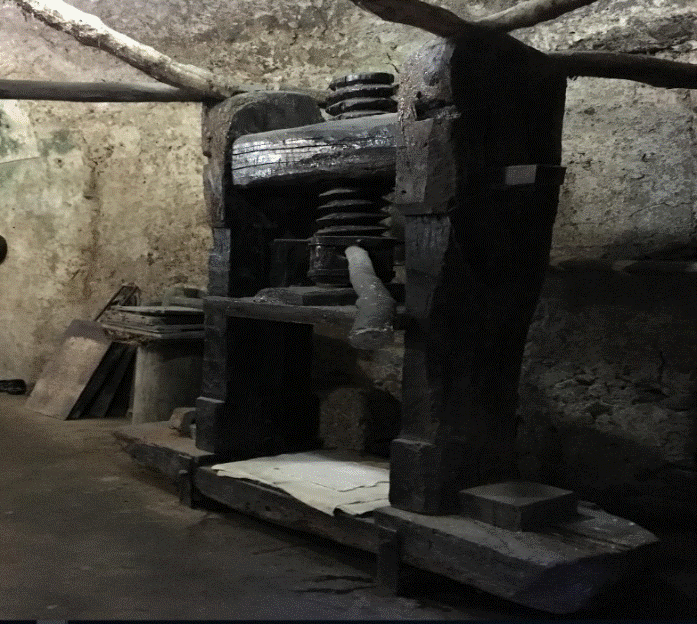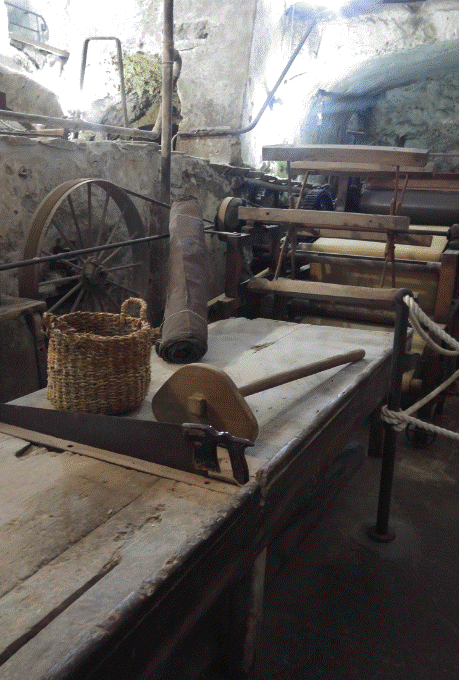

During a recent vacation to Italy, my wife and I had the opportunity to tour the Museo della Carta (Paper Museum) in the town of Amalfi. One source I came across referred to this museum as “a jewel of industrial archaeology,” and I fully agree. Built in the 14th century this is oldest remaining paper factory in Europe. It continued manufacturing paper until the middle of the 20th century. The museum still produces small quantities of the highly desirable “bambagina” paper for sale in its small gift shop, along with beautiful artisanal note cards and other items made from bambagina. According to one Amalfi Coast tourist site, to this day, artists around the world appreciate this very soft, thick, and elegant rag paper. It certainly is a far cry from the paper we regularly feed into our copy machines and printers! At the Amalfi paper factory-cum-museum, a stream runs right under this cavern-like building, which powered all the machines and provided the prerequisite clean “process” water. While crude by today’s standards, many of these machines were quite ingenious in design and demonstrated that manufacturing innovation has a long history.
Please note that, either due to the language barrier in this case, or a general vagueness about the specifics of the early papermaking process in Europe that I detected in my subsequent research for this blogpost, some of what follows represents educated conjecture, rather than absolute fact.
As we learned, initially, the bambagina paper was made by using wooden paddles to manually break down the fibers in carefully selected cotton rags. This was later replaced by a water-powered wheel with paddles to beat and stamp the rags to physically break down the fibers, which I believe may have been called a “Hollander” machine, since the technology originated in that country. It’s interesting to note that then - as now – that putting this advanced technology into the hands of an incompetent operator could have negative results, since it tended to speed up the process of manufacturing sub-standard paper. Also, it appears that another drawback of the Hollander-style machine, was that it could not be easily adjusted (if at all) to accommodate different feedstock quality and characteristics. Astute readers will note that this is a shortcoming common to many pre-digital-age machines and processes.
Once the rags were beat or stamped into fiber, hand pulling tools were used to transfer the fiber to a large stone vat filled with water and caustic chemical, where the vatman pounded it further with wooden paddles to turn it into a pulpy, gelatinous mass. Note that for improved ergonomics, this vat was just tall enough to allow a worker to bend over it comfortably.
After the vatman manually determined that the pulp has been adequately agitated and the consistency and fiber length was correct (based on his experience), he carefully scooped quantities out of the tub using a sheet-forming screen or “mould.” This was a rectangular wooden frame covered with a woven brass-wire surface over which the pulp could be evenly spread and, through skillful shaking, the fibers would knit together to form pasty paper sheets. The vatman then allowed the excess water to drain back into the vat. The paper sheets were then carefully applied to felt sheets by hand and stacked up in layers in a powerful wooden screw press to manually squeeze out the water. After being squeezed in the press, the sheets were then removed from the felt and carefully hung out to slowly air dry.
I found a really interesting historical description of this general process (not specific to Amalfi) in an essay on European papermaking by Timothy Barrett. A few excerpts follow:
After dipping the mould into the vat and raising it horizontally to the vat surface…the vatman spreads the stuff on the mould by gently shaking from right to left and from left to right, as if he wished to riddle it, until it is spread equally over the whole surface of the mould; this is known as “promener”: or to “shake”. In the same way, by another movement which is made by pushing the mould forward and pulling it back in a to and fro motion, as if riddling, the stuff binds and knits together and becomes perfect; this is known as “serrer” or to “shut” the sheet. These two movements are accompanied by a slight shake which serves to “put together” the sheet, that is to say to fix and bind it; but they are carried out very quickly with seven or eight movements of the hands and in the space of four or five seconds. Immediately this stuff, so fluid, which seems no more than slightly cloudy water, knits together. . . . In this way the sheet precipitates onto the brass screen while the water drains away through the interstices and a real sheet of paper remains on the mould.
One's characteristic “shake” could be lost, a result of too much drink, injury, old age, or other infirmity. Leonard Rosenband cites one instance of a vatman who was not rehired because “he was no longer sure of his weights” [paper thickness from sheet to sheet]. Once the layer of pulp had coalesced on the surface of the mould, the vatman removed the deckle and pushed the mould to the coucher. Fitting the deckle to the second, empty, mould, the vatman immediately began the formation of another sheet. The coucher meanwhile grasped the first mould and, turning it upside down, pressed it with a rocking motion against a damp woolen felt, transferring the fresh sheet of paper, smooth and unwrinkled, to the surface of the felt. The empty mould went back to the vatman, who by this time had already made another sheet. The coucher covered the fresh sheet of paper with another damp felt, and the routine continued, building up a repeated sandwich, or “post,” of fresh sheets interleaved with felts.
Clearly, this was a painstaking and time-consuming process that required conscientious effort by skilled craftspeople to create high-quality paper sheets. This process was light years away from today’s highly automated, rigidly quality controlled pulp and papermaking processes. Nevertheless, the skilled craftspeople in this dark, dank, largely subterranean factory in Amalfi (and elsewhere in the Amalfi region) produced some of the finest paper being manufactured in Europe at the time and its paper was in high demand for printing books and legal documents.
As previously mentioned, with an eye toward mechanizing the process, sometime in the 18th and 19th centuries, the Amalfi papermakers incorporated some new machines into the process. This included a mechanized continuous machine with large rollers that sped up the process, eliminated much of the manual effort, and improved the repeatability of the process and quality of the paper. Our tour guide proudly mentioned that this robustly constructed machine had been operating and producing bambagina in quantity well into the middle of the last century, the last of the many paper mills in the Amalfi region to do so.
This was quite a contrast from the last pulp and paper mills I had visited in a previous career with a large industrial automation supplier about a decade ago. These mills had been equipped with the highly automated continuous (pulp) digesters and huge, automated paper machines integrated with precision scanners to ensure precise, uniform thickness, moisture content, smoothness, and other key characteristics.
Clearly, like much else in this world, paper making has come a long way, largely due to new and innovative machines, automation, and other technologies. Even in today's high-tech world, however, it's important to always remember the value of the human element.




